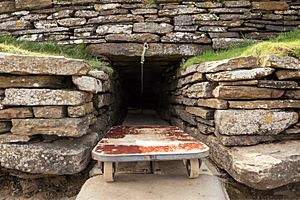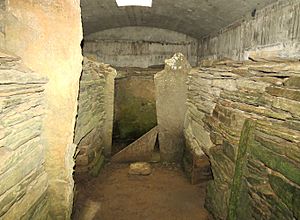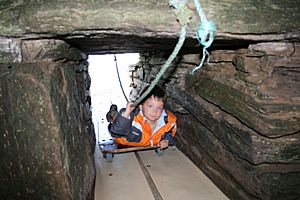Tomb of the Eagles facts for kids
The Tomb of the Eagles, also known as the Isbister Chambered Cairn, is an ancient burial place from the Neolithic period. It's located on a cliff at Isbister, on South Ronaldsay in Orkney, Scotland.
A farmer named Ronald Simison found the site in 1958 while digging for stones. He did some digging himself and found bones and skulls. He then covered the site back up. Later, in 1976, a bigger excavation started, and many more items were found.
An archaeologist named John Hedges studied the tomb fully after Mr. Simison told him about it. Hedges wrote a detailed report and a popular book, which helped give the tomb its famous name.
Contents
What Was Found Inside the Tomb?
Inside the Tomb of the Eagles, archaeologists found about 16,000 human bones. These bones came from at least 324 different people. However, no complete skeletons were found.
Mixed with the human bones were bones and talons (claws) from eight to 20 birds. These bird remains mostly belonged to the white-tailed sea eagle.
At first, some people thought the eagles were special animals, like a "totem," for the people buried there. But newer research showed that the eagle bones were added much later.
When Were the Eagles Added?
New dating methods showed that the eagles died around 2450–2050 BCE. This is up to 1,000 years after the tomb was first built! This discovery helps us understand that these ancient tombs in Orkney were used for many generations.
Who Built This Amazing Tomb?
Experts believe the people who built the tomb had "sophisticated architectural design" skills. They also had "advanced engineering skills" and understood astronomy and mathematics. This is amazing, especially since they only had simple tools.
Radiocarbon dating suggests that building the tomb might have taken a whole century. Archaeologists think the tomb "was used regularly for 800 years," with the last burial around 1600 BC.
What Can We Learn About the People?
Studying the bones tells us that these ancient people lived active and healthy lives. However, they also had many injuries and diseases, much like people today. A closer look at 85 skulls showed that at least 20% had signs of injury, possibly from wooden clubs or stone axes.
How to Visit the Tomb
To get inside the tomb, you have to go through a low tunnel that is about 3 meters (10 feet) long. Visitors can lie flat on a wheeled trolley to go through the tunnel. Once inside, you can stand up in the main part of the tomb.
See also
 In Spanish: Tumba de las Águilas para niños
In Spanish: Tumba de las Águilas para niños




